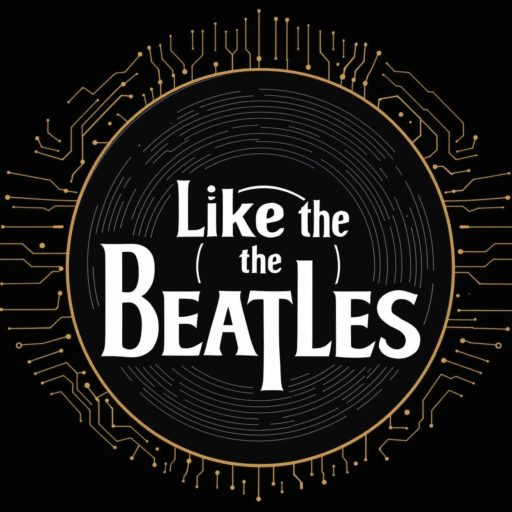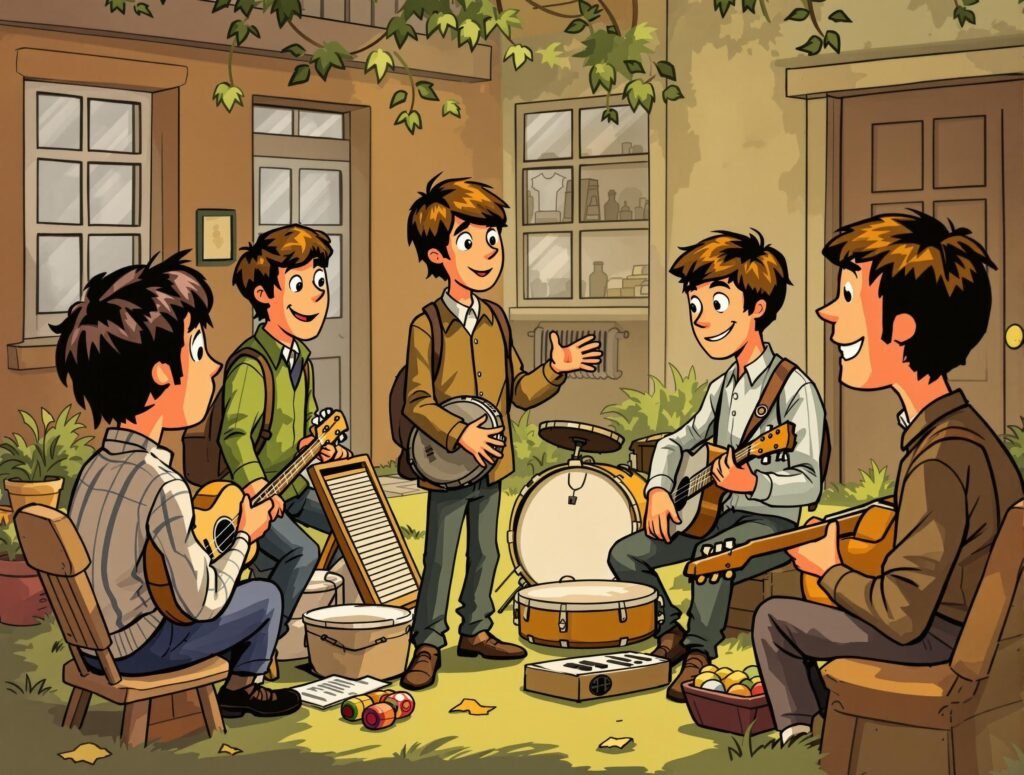The Quarrymen: Where The Beatles’ Legend Began
Forget grand stadiums and screaming fans. The incredible story of The Beatles started humbly in mid-1950s Liverpool, not with global superstars, but with a handful of teenagers, some rudimentary instruments, and an undeniable urge to make noise. This is the tale of The Quarrymen, the unpolished, unlikely starting point for what would become the most influential band in history. It’s the essential first chapter, where the legend truly began to hum.
The Skiffle Spark: Music for Everyone!
In post-war Britain, particularly in working-class cities like Liverpool, a musical phenomenon was sweeping the nation: skiffle. This wasn’t about expensive instruments or years of classical training. Skiffle was the ultimate DIY genre – a raw, energetic blend of folk, blues, and jazz, often played on anything that could make a sound. Think acoustic guitars, a repurposed tea chest for a bass, and a washboard scraped with thimbles for percussion. It was fun, fast, and anyone could join in—even if your “bass” was just a tea chest with a broomstick.
This spirit perfectly captured the imagination of a young, restless John Lennon. John, brimming with charisma and a rebellious streak, wasn’t much for formal music lessons. He devoured rock and roll records, but skiffle, inspired by stars like Lonnie Donegan, was the perfect entry point for a budding musician eager to lead his own band.
So, in 1956, while attending Quarry Bank High School, John formed his first group. What better name than The Quarrymen, a direct nod to their humble school origins? As original drummer Colin Hanton remembered:
“We weren’t looking to change the world. We just wanted to make a bit of noise and have a laugh.”
The Early Lineup: Homemade Sounds and Shared Dreams
The initial incarnation of The Quarrymen was less a fixed band and more a loose collective of John’s school friends and neighbours. Their instruments were often basic, sometimes homemade, reflecting the true skiffle spirit. The first lineup was a true mix of personalities and sounds:
- John Lennon: Vocals and acoustic guitar, leading the charge.
- Pete Shotton: John’s closest pal, providing the rhythmic heart on a washboard.
- Eric Griffiths: A steady presence on acoustic guitar.
- Rod Davis: Plucking the banjo, adding that distinctive skiffle twang.
- Len Garry: Handling the tea chest bass.
- Colin Hanton: Keeping the beat on drums.
They practiced wherever they could—living rooms, backyards, even on the street. “If you had a guitar or could keep a beat, you were in. That’s how it worked,” joked Len Garry. Their music was rough around the edges, but their energy made up for it. “We were just kids messing about, trying to copy the records we loved. Nobody had any idea where it would lead,” said Rod Davis. John Lennon’s sense of humor and natural stage presence quickly made him the informal leader, even if the band sometimes fell apart mid-song.
The Pivotal Garden Fete: John Meets Paul
The most crucial moment in The Quarrymen’s history, and arguably in music history, came on July 6, 1957. The band was playing at the St. Peter’s Church Hall garden fete in Woolton, Liverpool. The sun was out, the atmosphere was relaxed, and destiny was about to unfold. In the crowd was a quietly confident fifteen-year-old named Paul McCartney, who was introduced to John by their mutual friend, Ivan Vaughan.
After The Quarrymen’s set, Paul showed off his skills by playing Eddie Cochran’s “Twenty Flight Rock” on guitar, along with Gene Vincent’s “Be-Bop-A-Lula”. “I was nervous, but I knew all the chords and words. John watched and you could see the wheels turning,” Paul McCartney later recalled. John was undeniably impressed and soon invited Paul to join The Quarrymen, forming the foundation of their legendary songwriting partnership. This event, now iconic, marked the true beginning of the Fab Two.
Evolution and the First Recording
With Paul on board, the band’s sound grew stronger. Paul brought in his friend George Harrison, a talented young guitarist. After an impromptu audition on the top deck of a Liverpool bus (George was only 14 at the time, but his guitar playing immediately wowed the others), George joined too. The lineup continued to change often, but the core of John, Paul, and George was now set, forming the essential trio. As Colin Hanton observed:
“John and Paul were like two sides of the same coin—always pushing each other, always trying to outdo each other.”
In 1958, The Quarrymen saved up their shillings (a total of 17 shillings and sixpence) to make their very first recording at Phillips’ Sound Recording Service in Liverpool. They recorded Buddy Holly’s “That’ll Be the Day” and, remarkably, an original song called “In Spite of All the Danger,” co-written by Paul and George. Only one copy of this precious record was made, and the band famously passed it around for years. “It was like a badge of honour—whoever had the record was king for a day,” said Len Garry. This recording is now a prized piece of Beatles history, an undeniable testament to their earliest creative efforts.
The Transition: Becoming The Beatles
As skiffle’s popularity eventually faded, some of the original Quarrymen members, who were more tied to the skiffle genre, amicably moved on. But John, Paul, and George, driven by their passion for rock and roll, kept going. They experimented with new sounds and changed their name a few times—briefly becoming Johnny and the Moondogs, then The Silver Beetles—before finally adopting the name The Beatles in 1960, just before their pivotal residencies in Hamburg.
“We didn’t know we were making history. We were just making music,” Colin Hanton reflected. And indeed, they were. The Quarrymen’s story is powerful proof that big things can start in small places. With a few friends, some basic instruments, and a whole lot of enthusiasm, they laid the foundation for the most influential band in history and changed music forever.

